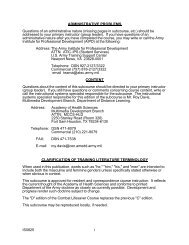MCWP-3-11.3-Scouting-and-Patrolling
MCWP-3-11.3-Scouting-and-Patrolling
MCWP-3-11.3-Scouting-and-Patrolling
You also want an ePaper? Increase the reach of your titles
YUMPU automatically turns print PDFs into web optimized ePapers that Google loves.
<strong>Scouting</strong> <strong>and</strong> <strong>Patrolling</strong> _________________________________________________________________________________ 10-5This will be the only opportunity for the patrol leaderto issue detailed instructions. The mission, in particular,must be unmistakably clear so that once thepatrol is committed, all subordinate leaders can actwith unity of purpose.Whenever possible, the patrol leader should have aMarine, such as the navigator, build a terrain modelusing dirt, s<strong>and</strong>, twigs, etc., explaining the concept ofoperations for movement to the objective area, actionsat the objective area, <strong>and</strong> the return. Terrain modelsprovide patrol members with a clear <strong>and</strong> simple layoutof the area of operations <strong>and</strong> key terrain.SuperviseInspections <strong>and</strong> rehearsals, vital to proper preparation,are conducted even though the patrol leader <strong>and</strong> patrolmembers are well experienced in patrolling. Inspectionsdetermine the patrol’s state of physical <strong>and</strong>mental readiness.The patrol leader inspects before rehearsals to ensurecompleteness <strong>and</strong> correctness of uniform <strong>and</strong> equipment.The following areas are checked:l Camouflage.l Identification tags, Geneva Convention cards.l Prescribed equipment, weapons, <strong>and</strong> ammunitionare available <strong>and</strong> serviceable.l Tape <strong>and</strong> other items are used to “silence” equipment(prevent noise produced during movement).l Items that could provide information to the enemy(e.g., letters <strong>and</strong> papers) remain behind.l Unnecessary equipment <strong>and</strong> excess weight remainbehind.The patrol leader questions each patrol member toensure the following is known:l The mission, planned routes (primary <strong>and</strong> alternate),<strong>and</strong> the fire support plan of the patrol.l The individual’s role: what to do <strong>and</strong> when to do it.l What others are to do <strong>and</strong> how their actions impact.l Challenges <strong>and</strong> passwords, codes, reporting times,radio call signs, frequencies, <strong>and</strong> any other pertinentdetails.There is usually a period of time between final rehearsal<strong>and</strong> departure. The patrol leader reinspects justbefore departure to ensure all equipment is still inworking order <strong>and</strong> the unit is ready to embark on themission.Rehearsals ensure the operational proficiency of thepatrol. Plans are checked <strong>and</strong> needed changes aremade. The patrol leader verifies the suitability ofequipment. It is through rehearsals that patrolmembers become thoroughly familiar with the actionsto take during the patrol.If the patrol will operate at night, both day <strong>and</strong> nightrehearsals are conducted. Terrain similar to that overwhich the patrol will operate is used. All actions arerehearsed. If time is limited, the most critical phasesare rehearsed. Action at the objective is the mostcritical phase of the patrol <strong>and</strong> is always rehearsed.An effective method is to talk the patrol through eachphase, describing the actions <strong>and</strong> having each memberperform individual duties. When satisfied, the patrolleader walks the patrol through all phases of the patrolusing only the signals <strong>and</strong> comm<strong>and</strong>s to be usedduring the actual conduct of the patrol. Rehearsalscontinue until the patrol is thoroughly familiar withthe plan. The rehearsal is also used to test the soundnessof the patrol order <strong>and</strong> patrol organization.After the rehearsal, the patrol leader makes final adjustmentsto the plan <strong>and</strong> patrol organization based onwhat was learned during the rehearsal <strong>and</strong> from othersources, such as the S-2 <strong>and</strong> adjacent patrols. Whenthis is completed, the patrol leader issues final instructionsto subordinate leaders noting any changesmade in the patrol organization or plan. While thesubordinate leaders are briefing the remainder of thepatrol members, the patrol leader reports to the comm<strong>and</strong>erstating that the patrol is ready to begin themission. The patrol leader also coordinates the location<strong>and</strong> time that the patrol can test fire all weaponsprior to departure.



